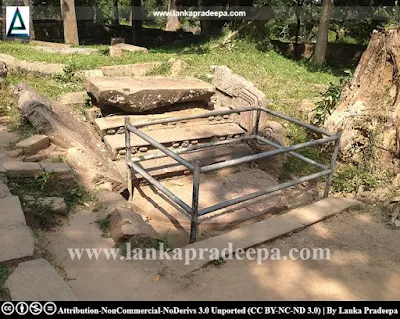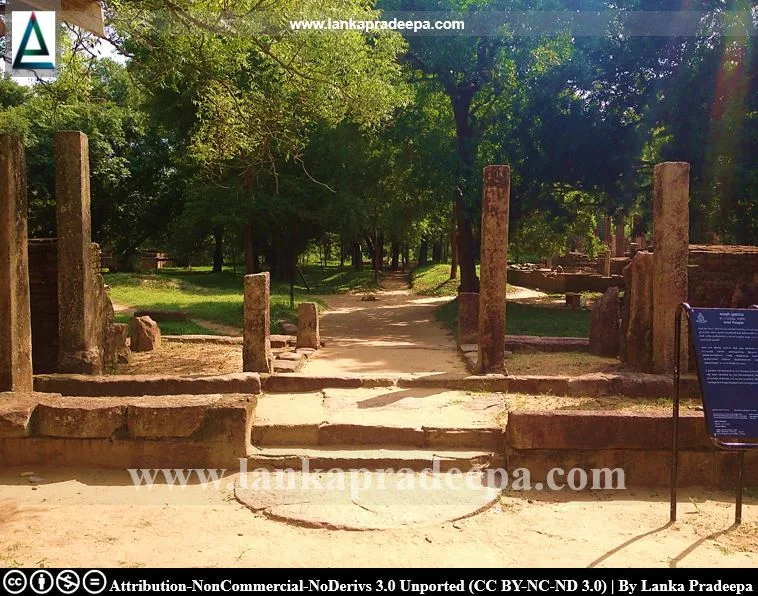
Magul Maha Viharaya (Sinhala: ලාහුගල මගුල් මහා විහාරය) is an ancient Buddhist temple located in Lahugala in Ampara District, Sri Lanka. The site can be reached by travelling along Pothuvil - Siyambalanduwa road about 14 km distance from Pothuvil town.
History
The origins of Magul Maha Viharaya are believed to be connected to the period of King Kavantissa (205-161 B.C.), who reigned the region of Rohana during the rule of the invader Elara (205–161 B.C.) from India over the Anuradhapura Kingdom. Tradition holds that the auspicious occasion of the royal union between King Kavantissa and Vihara Maha Devi, the daughter of King Kelani Tissa, transpired at this very location.
However, two inscriptions found from the site say that a queen named Vihara Maha Devi restored the ruined Runu Maha Vera founded by King Dasen-kali (Nicholas, 1963; Paranavitana, 1934). Therefore, from the details given in the inscription, it is believed that the ancient name of Magul Maha Vihara was Runu Maha Vehera (Rohana Maha Vehera) and it was originally founded by King Dhathusena [(c. 516 to 526 A.D.) Paranavitana, 1934]. However, chronicles do not mention King Dhatusena with the establishment of this temple but Mahawamsa and Pujavaliya record that a Vihara named Ruhunu Vehera (Rohana Vehera) was established by Dappula I (c. 650 A.D.), a ruler of Rohana (Paranavitana, 1934). He had built Ruhunu Vehera to honour the Maha Thera of Pasanadipika Vihara which is today identified with a large isolated rock called Neelagiriya, located south of Lahugala (Nicholas, 1963). According to Paranavitana (1934), the Runu Maha Vera of these two inscriptions and the Ruhunu Vehera of the chronicles are doubtless identical even though there is a discrepancy in the name of the founder (Paranavitana, 1934).
Vihara Maha Devi, the name of the queen who is mentioned here is the chief consort of both King Parakramabahu V (1344-1359 A.D.) and King Bhuwanekabahu IV [(1341-1351 A.D.) of Gampola Period (Paranavitana, 1934).

Magul Maha Vihara Slab Inscription
Period: 14th century A.D.
Script: Medieval Sinhala
Language: Medieval Sinhala
Transcript: (Svasti) [Sri Si]ri lak-hi rajaka[la] Dasen-kali raja daruvan da karavu Runu maha vera....>>
Translation: Hail! The Runu Maha Vera founded by Dasen kali who reigned in prosperous Lanka....>>
Content: Vihara Maha Devi, the chief consort of the two brother kings named Parakumba, who vanquished the Colas and governed the Ruhuna, restored the ruined Ruhunu Maha Vihara founded by King Dasen kali and provided requisites for maintenance of Sangha and attendants. Also, the Viharadevi Pirivena founded in her name attached to this monastery should be known and all these institutions should be maintained continuously by the future kings.
Reference: Paranavitana, 1934

Magula Maha Vihara Pillar Inscription
Script: Medieval Sinhala
Language: Medieval Sinhala
Transcript: <<...Vihara maha devin bim pisa karavu Runu maha vera...>>
Translation: <<...the Runu maha vera, caused to be entirely rebuilt by Vihara maha devi...>>
Content: Vihara Maha Devi, the chief consort of the two brother kings named Parakumba, restored the ruined Runu Maha Vera. This dedication to the Dharmaratna should be maintained by people coming in the future
Reference: Paranavitana, 1934
Other Inscriptions and Ruins
A medieval Sinhalese inscription belonging to the 9th-10th century A.D. has been found on a stone slab fixed to the outer wall of the Stupa foundation (Dias, 1991). Another slab with an inscription of the 8th-10th centuries A.D. is found fixed in the outer Prakara of Magul Maha Vihara and it was copied by the Archaeological Department in 1935 (Dias, 1991).
A large number of archaeological ruins can be seen at the present temple premises. Ruins of a Bodhighara (Bodhi tree house), an image house, a Chapter House, a Stupa, and a parapet wall demarcating the boundary of the temple have been identified and conserved by the Archaeological Department.

Magul Maha Vihara Sandakada Pahana
The Sandakada Pahana (moonstone) found in Magul Maha Viharaya belongs to the Anuradhapura period and is considered an eminent piece of work. It depicts a row of elephants with a rope across their belly. Two human figures (probably mahouts) who are found on the back of two of these elephants have made this artefact unique among the moonstones found in other places in Sri Lanka (Wisumperuma, 2012).
A Protected Site
Magula Maha Viharaya situated in the village of Lahugala, in the Divisional Secretary’s Division of Lahugala is an archaeological protected monument, declared by a government gazette notification published on 26 March 1954.



 .
.
References
1) Dias, M., 1991. Epigraphical notes (Nos 1 -18). Colombo: Department of Archaeology. pp. 44,59.
2) Nicholas, C.W., 1963. Historical topography of ancient and medieval. Journal of the Ceylon branch of the Royal Asiatic Society. New series, Vol. VI, Special number. Colombo. p.23.
3) Paranavitana, S., 1934. Two inscriptions of Vihara Maha Devi from Magul Maha Vihara. Epigraphia Zeylanica being lithic and other inscription of Ceylon. Vol. IV. Archaeological survey of Ceylon. London. pp.161-169.
4) The government gazette notification. No: 10657. 26 March 1954.
5) Wisumperuma, D., 2012. Religious Use of Elephants in Ancient Sri Lanka. GAJAH. p.17.

